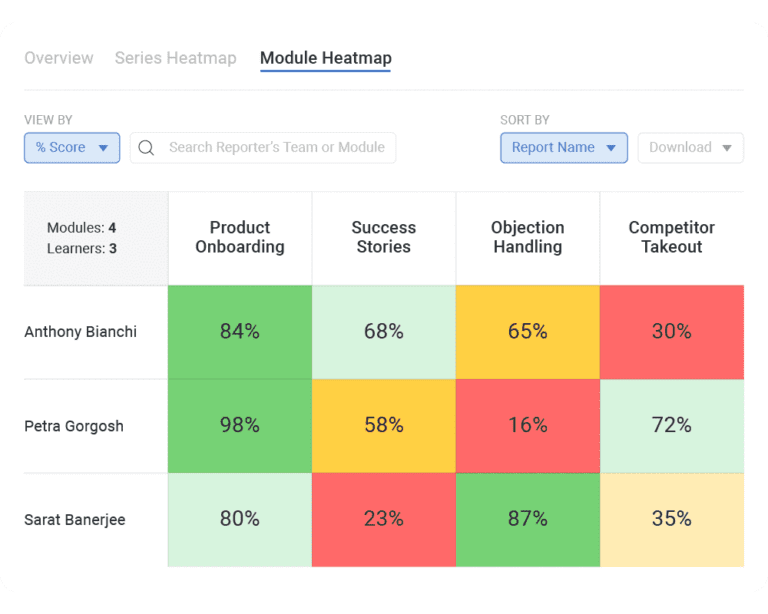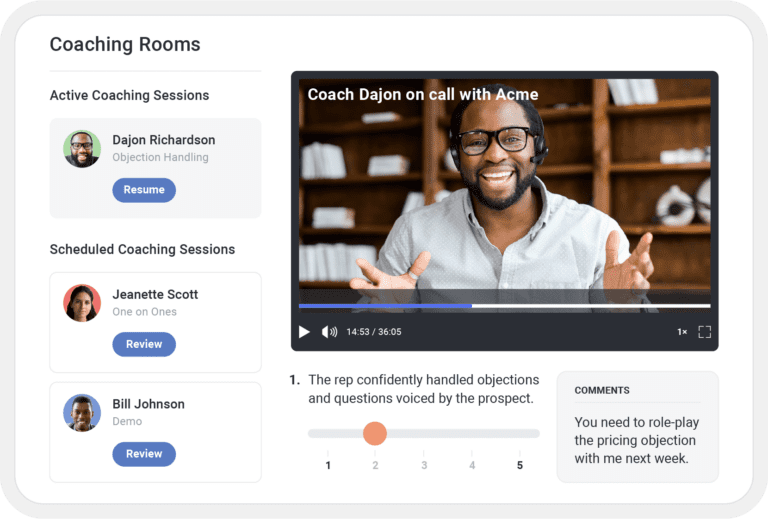Think of your most recent major purchase – either in your personal or professional life. Chances are, the interactions you had with the sales rep had a significant impact on your purchase decision.
If so, you’re not alone. Sellers who effectively engage their sellers are more likely to close deals. It’s as simple as that.
But taking a random, ad hoc approach to sales engagement isn’t effective. Instead, the most successful sales organizations understand the importance of a solid sales engagement plan.
In this post, we’ll explore what sales engagement is, why it’s important, and how sales engagement differs from sales enablement. We’ll also explore steps you can take to create a plan that empowers your sales reps to build relationships, foster trust, and close more deals.
What is sales engagement?
Sales leaders recognize the need for effective sales engagement. In fact, recent research from Gartner found that 90% of sales leaders plan to invest in “technologies and methodologies to help their sellers engage effectively with prospects and customers.”
Gartner research found that
But what is sales engagement?
The term refers to all interactions a sales rep has with their buyers. This includes:
- Email interactions
- Phone calls
- Interactions on social media
- Face-to-face interactions
Why is sales engagement important?
Now, we’re in alignment about what sales engagement is. But why does it matter?
Great products and services are still important. That will never change. But the experiences a buyer has with your brand also have a big impact on whether they choose your solution – or opt for another.
A sales rep who effectively engages with a buyer is more likely to earn their trust – and ultimately, their business. After all, people want to do business with people they like and trust. Of course, when sellers close more deals, your business’ revenue grows.
On the flip side, if a seller struggles to engage buyers, they’re more likely to lose deals. Over time, this will have a negative impact on your bottom line.
Sales engagement vs sales enablement: How are they different?
These two terms are often used interchangeably. Though they’re certainly related, they’re not the same thing.
As we’ve already covered, sales engagement is focused on the interactions a sales rep has with their prospective buyers. As a general rule, better sales engagement leads to better sales outcomes.
On the other hand, sales enablement is focused on providing sales teams with the tools, training, information, content, and support they need to close more deals. Every seller needs a certain set of tools and competencies to be successful in the field. Sales enablement is focused on ensuring sellers have mastery of those skills and competencies.
There is often overlap between the two. For example, a sales enablement team may develop a training module on more effective email communication. Or, they may provide the sales team with email templates for sellers to use in their interactions. These are both examples of sales enablement. However, the goal of these initiatives is to improve sales engagement.
| Sales engagement | Sales enablement | |
|---|---|---|
| What is it? | Interactions and communication sellers have with prospects throughout the purchase journey | Equipping sales reps with the training, tools, content, and information they need to be successful in the field. |
| What is the focus? | Buyers | Sellers |
| What is the goal? | Building trust and fostering relationships with prospects | Ensuring sales reps have the skills and competencies needed to close more deals |
| What are the key components? | Calls, emails, face-to-face interactions, sales engagement platform | Sales coaching, sales content, sales enablement platform |
| KPIs | Win rate, quota attainment, time to close | Completion rates, ramp time, productivity |
How to create a sales engagement plan
Leaving your sellers to their own devices usually isn’t the best approach. Instead, it’s best practice to develop a plan first.
What is a sales engagement plan?
Think of your plan as a documented outreach roadmap for your sales team. It’s a framework that outlines how and when sellers should engage with buyers. It should also cover how sales reps can leverage the technology that’s available to them to improve sales engagement.
A sales engagement plan isn’t based on what sales leadership thinks will work. Instead, it’s based on what’s proven to work for that particular organization.
Your plan must be flexible. For example, if a prospect is largely sharing negative feedback during interactions, it’s probably best to back off, rather than proceed with the next outreach effort.
Tips for developing an effective sales engagement plan
What does a winning plan look like? There’s no easy answer. The right plan is the one that works best for your business.
However, there are certain steps you can take to help ensure you create an effective one.
Before developing a plan, it’s important to take a step back to define who it is your sellers are engaging with on a daily basis. You should define who these prospects are, what titles they hold, and what their key challenges and pain points are (among other things). You may already have this information documented in ideal customer profiles (IDPs) or buyer personas.
At many organizations, marketing teams spend time creating content to support sales engagement. For example, a marketing team might develop email campaigns tailored to specific industries. Or, they might develop social media content that sales reps can post on their own social media channels. Those are just a couple examples.
But all too often, marketing content is created in a vacuum – without input from the sales team. That’s a big mistake.
Instead, marketing and sales teams must be aligned on content creation. A great way to do this is to schedule a recurring meeting between the two teams.
During these meetings, sales teams can provide feedback to marketing teams on their challenges in the field. Then, marketing teams can create content that addresses those challenges.
When marketing and sales teams are aligned, sales reps are more likely to have the content they need to increase sales engagement and ultimately, close more deals.
There are many stages of the sales journey – from prospecting to closing the deal. It’s important to define what this journey looks like for your customers. Your sales team can provide great insight on this topic.
Once you’ve defined the customer journey, you can create a plan to effectively engage prospects every step of the way.
After you’ve documented the customer journey, it’s time to determine the key touchpoints a sales rep will have throughout the journey. This might include:
- Marketing emails
- Emails from the sales rep
- Phone calls
- Voicemails
- Engagement on social media
This will provide reps with a framework they can use to understand what step to take when.
How many customer touchpoints should there be? Again, there’s no easy answer. It depends on a number of factors including industry and how engaged the buyer is.
The right content can help your sales reps effectively engage with buyers. Sales and marketing teams should take an inventory of existing content and determine where there may be gaps. Then, these teams can work together to develop content to engage buyers throughout the purchase journey.
The best place to store completed sales content is in a sales content management solution. That way, sellers can always find the latest versions of any content they need – all in one place. In addition, organizations can track how both buyers and sellers are engaging with this content – and how (or whether) it’s impacting sales outcomes.
It’s important to remember that buyers are more informed than ever before. Often, they’ve done plenty of research on their own.
As such, generic, one-size-fits all outreach, communication, and campaigns aren’t effective. Instead, it’s important to develop targeted, personalized campaigns that address the challenges and pain points of each prospect.
You can’t simply develop your sales engagement plan – and then never think about it again. Instead, it’s important to monitor and measure the success of your sales engagement plan on an ongoing basis.
Make it a priority to examine your sales engagement and sales enablement dashboards and analytics on a regular basis. In addition, ask for feedback from your sales team. Your top sellers have great insight into what’s working and what isn’t. Then, use the insights you uncover to make impactful changes to your sales engagement plan.

How to choose a sales engagement platform for your business
The right technology is essential to a successful strategy. After all, sellers need the right tools to effectively engage with buyers.
Increasingly, sales teams are leveraging B2B sales engagement software to improve sales engagement at scale. In fact, research from Gartner tells us that 87% of sales teams use a sales engagement platform.
According to Gartner
Not all tools are the same, though. It’s important to find the right sales engagement platform for your organization. The right platform will have robust features and functionality that automate and optimize sales engagement and improve outcomes at your organization.
A revenue productivity platform can also help ensure sellers are ready to engage with buyers throughout the sales cycle.
A revenue productivity platform like Mindtickle equips sellers with the training and content they need to effectively engage sellers throughout every stage of the sales journey. In addition, a revenue productivity platform with conversation intelligence helps sales managers understand how sales reps are engaging with buyers on calls. These insights can shed light on opportunities for additional coaching to improve sales engagement.


Finally, strong revenue productivity solution provides robust analytics that help sales leaders understand how buyers and sellers are engaging throughout the sales cycle. Sales leaders can use these insights to optimize their sales engagement plan and ensure their sellers have what it takes to effectively engage with any buyer.
Sales Enablement in Mindtickle
Ready to see how Mindtickle helps winning sales organizations boost sales engagement at scale?
Request a Demo






